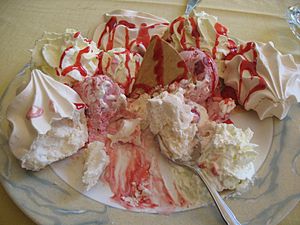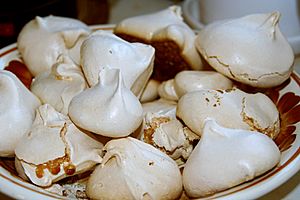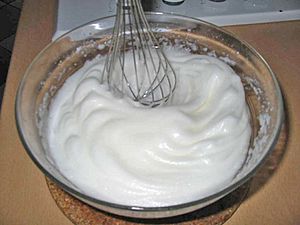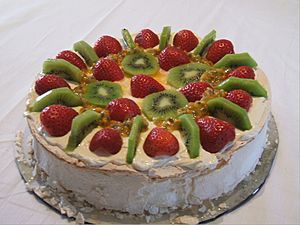Meringue facts for kids
A meringue is a light and sweet dessert. It is made by mixing egg whites with sugar and whipping them until they are fluffy. Sometimes, people add cream of tartar or cornstarch. These ingredients help the meringue hold its shape. Meringues often taste like vanilla, almond, or coconut. They are known for being very airy and sweet.
Contents
How Meringue Got Its Name
People are not completely sure where meringue came from. Some believe it was invented in a Swiss town called Meiringen. An Italian chef named Gasparini might have created it there.
The name meringue first appeared in a cookbook in 1692. This book was written by François Massialot. The word was then used in English in 1706. This was when Massialot's book was translated. Older English recipe books also had similar recipes. They called them "white biskit bread" or "pets."
Different Kinds of Meringue
There are several types of meringue. The most common kind is dry and crispy.
Some meringues are only partly cooked. You can find them on desserts like queen of puddings, key lime pie, and lemon meringue pie. There are also meringues that are not cooked at all. Others are cooked in different ways.
Once cooked, meringues should not be put in the fridge. They can become soggy if they get too cold or wet. It's best to keep them in a container that seals tightly. They will stay fresh for about a week this way.
Meringue is also a popular topping. It's used on desserts like angel food cake, pavlova, and baked Alaska.
The Science Behind Meringue
When you beat egg whites, something cool happens. The proteins in the egg whites start to unfold. This is called "denaturing." As they unfold, they link up with each other. They create a strong network. This network traps air bubbles. That's what makes the egg whites become stiff and foamy. This foamy texture is perfect for making meringues.
Adding cream of tartar helps this process. Using a copper bowl can also help. These things make the proteins unfold even better. This helps the meringue get those firm, stiff peaks. If your bowl is wet or greasy, the meringue might not get stiff enough. Wiping the bowl with a lemon wedge can remove grease.
When you beat egg whites, they go through stages.
- Soft peaks: The peaks fall over when you lift the beater.
- Firm peaks: The peaks hold their shape but the tips curl slightly.
- Stiff peaks: The peaks stand straight up and hold their shape firmly.
Both egg whites and sugar love water. They are "hygroscopic." This means they pull moisture from the air. That's why meringue can get soggy if it's in a humid place. It can also "weep" or "sweat." This means small drops of water appear on its surface. This often happens if the sugar wasn't fully dissolved.
Images for kids
-
Lemon meringue pie with browned meringue peaks
See also
 In Spanish: Merengue (alimento) para niños
In Spanish: Merengue (alimento) para niños







